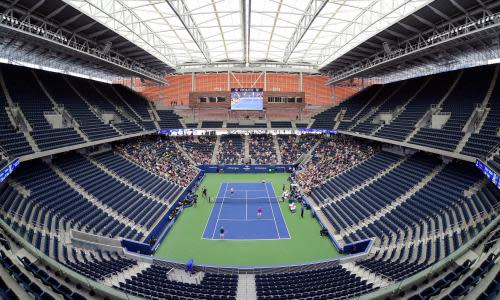US Open jazzes up Louis Armstrong Stadium to complete $600m rebuild
The US Open is serving up a number of changes as it celebrates its 50th birthday, including the introduction of a shot clock and the expansion of the Hawk-Eye line-calling system to all courts. But the biggest addition to the year’s final grand slam is the rebuilt Louis Armstrong Stadium, a gorgeous 14,061-seat venue that gives the event a second retractable-roof stadium – from none only three years ago.
READ MORE: Mourinho in no mood for discussion in bizarre press conference
READ MORE: Hazard could start on the bench again for Chelsea
READ MORE: Guardiola backs Kompany's plans to play on
It is the final jewel in the United States Tennis Association’s five-year, $600m transformation of the Billie Jean King National Tennis Center in New York.
Spectators got a first look at the terracotta-covered stadium at Wednesday’s formal dedication, where Michael Chang and James Blake defeated John and Patrick McEnroe in a legends doubles match before a crowd of several hundred onlookers as qualifying matches played out across the grounds.
Designed by the Detroit architectural firm Rossetti, the new Louis Armstrong Stadium is the world’s first naturally ventilated tennis stadium with a retractable roof, eliminating the need for an air conditioning system. The lower bowl of the arena will require a reserved ticket when the tournament properly kicks off on Monday, while the upper tier will be general admission for anyone at Flushing Meadows.
When Andy Murray saw off Novak Djokovic to win the US Open in 2012, it marked the fifth straight year the men’s singles final had been forced to Monday because of inclement conditions earlier in the fortnight. Eleven months later the USTA announced the ambitious expansion plan that has resulted in the construction of roofs over the two biggest show courts.
Danny Zausner, the chief operating officer at the National Tennis Center and overseer of the project, insists the timing was pure coincidence – but there is no question the comically unlucky run of weather and backlogged matches over that half-decade propelled the roof issue from a want to a need in the public eye. The benefits for the players, he says, are manifest.

“For the players that are playing in singles matches on either [Arthur] Ashe [Stadium] or Armstrong to be guaranteed to move through the tournament in pairs and not have to worry about rain delays, which might be five or 10 minutes as opposed to a day, is massive,” Zausner says. “The ability to know that the tournament will begin on Monday and end 14 days later on that Sunday is a big priority.”
The opening of Armstrong marks the end of an expansion that included the retrofitting of a roof above the 23,771-seat Ashe Stadium, the construction of a new 8,125-seat Grandstand, the wonderfully intimate Court 17 – already a favourite among regulars – and a renovated South Campus that includes 10 rebuilt outer courts.
The US Open makes no secret of the sprawling crowds it attracts: more than 700,000 fans generate ticket revenue of over $100m during the two-week tournament, a windfall that has enabled the USTA to finance the project without any public money. Zausner says the addition of evening sessions on Armstrong for the first six days will give them the ability to sell another 6,400 tickets per night, though fan experience remains the priority.
“We’re not looking to jam people in here. The goal is solving the crowding issue by creating more space. We put another 12,000 physical seats on the site. You’ve got 4,000 more on Armstrong, you’ve got 2,500 more on Grandstand and then throughout the grounds we put more seats.
“So even if we didn’t sell a single additional ticket, there’s just more space for people. But there’s definitely an opportunity for us to get anywhere from 30,000 to maybe as much as 100,000 more people at the tournament.”
No one is more enthused about the preservation of Armstrong than John McEnroe, who won all four of his US Open titles there when it was the tournament’s main court.
“We weren’t sure what was going to happen,” McEnroe said on Wednesday before taking to the court. “And finally not only did they put this unbelievable roof over Arthur Ashe Stadium but they decided to redesign this court and build this. I know the players are going to be super excited and as a New Yorker and a Queens boy I couldn’t be prouder of this stadium.”




